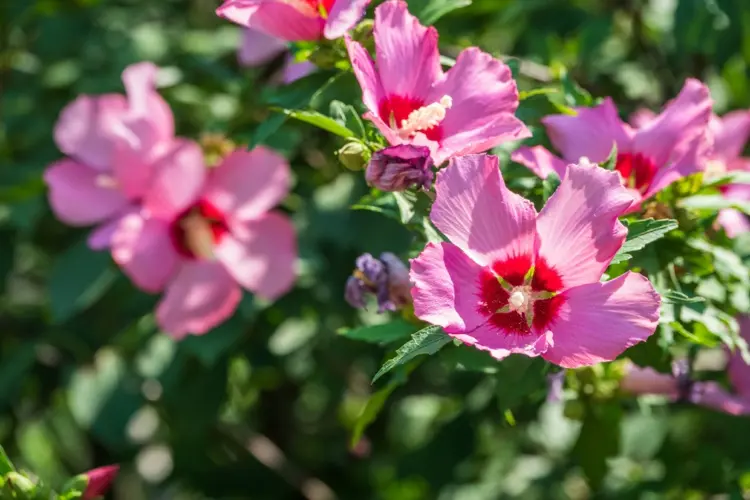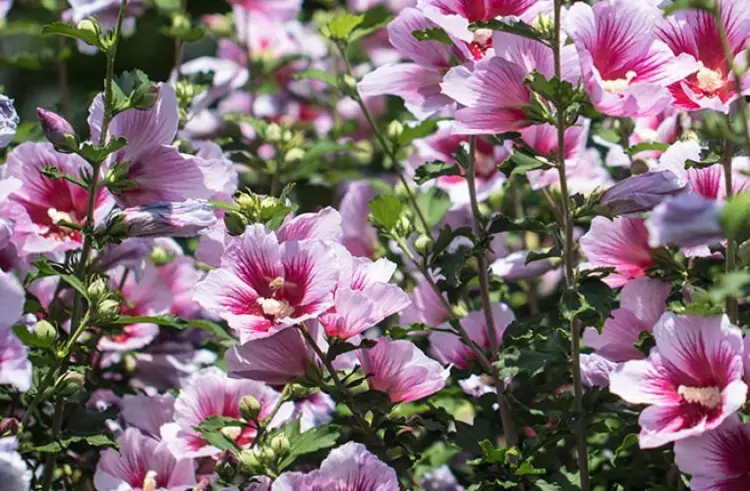Have you decided to expand your garden with one or two hibiscus bushes? That doesn’t surprise us at all, because it really is a wonderful specimen that not only impresses with a long flowering time and, above all, quantity, but is also very easy to care for once it has settled in. So that you give the shrubs a perfect start, whether as solitary plants or for a hibiscus hedge, you should of course plant them correctly. When and how exactly you plant a hibiscus in the garden and what mistakes you should avoid, we have summarized here.
Planting hibiscus in the garden: avoid these common mistakes!
In itself, the flowering shrub can easily thrive in our home gardens. So if your plant has died in the past without being affected by disease, you can be sure that you made a mistake. Therefore, keep the following in mind when planting a hibiscus in the garden:
The wrong time: When do you plant hibiscus?
A common mistake home gardeners make is planting at the wrong time. When should you plant the hibiscus in the garden?
Spring is ideal for planting a hibiscus bush because this plant loves warmth and light. After the ice saints, when there is no longer any danger of frost, is ideal. Then it has enough time until the end of the season to take root well and to move to the new location, which would not necessarily be guaranteed in autumn.
However, surviving the winter when planting in the fall is not impossible, as the shrub is not overly sensitive. You can help it get through the winter by applying frost protection to the root area. Either plant ground cover around the trunk or lay down a thick layer of mulch.

By properly preparing the soil, planting hole and soil, you help the plant to get used to it and give it the strength to grow. How to proceed:
Plant hibiscus in the garden – avoid a wrong location
First of all, the eventual size of the marshmallow is important because after a few years you don’t want to find it getting too crowded or even disturbing other garden plants with its size and then having to cut it down and transplant it. Two species are suitable for the garden in our climate regions and differ in their growth:
- The garden marshmallow grows as a shrub and reaches an impressive height of up to 3 meters. It is also very impressive in its width. Diameters of around 2 meters are the standard for him.
- The Perennial Hibiscus however, is much more compact. With a height of approx. 2 meters and a diameter of 30 centimetres, it is also well suited for smaller areas. In this species, the above-ground parts of the plant die off at the end of the season, after which the perennial sprout again in spring.
A common mistake regarding the location is that the following things are not taken into account:
- The shrub needs full sun.
- Since the plant is sensitive to strong winds, it needs a sheltered place.
- A sandy-loamy soil is best.
- The flowering shrub prefers slightly alkaline to acidic soil.
It is the first two points that are often underestimated and neglected and ultimately lead to the plant dying. Therefore, you should not make this mistake, but respond to the needs of the bush.
Prepare the planting hole step by step before

Once you have found the perfect location, you can already prepare it for planting. This is how you proceed when you plant a hibiscus in the garden:
- For the right size of the hole, simply use the root ball of your new garden plant as a guide. As a general rule, the hole should be twice the diameter so there is enough loose soil around the root ball to make it easier for the shrub to grow its roots through. Also, dig the hole a little deeper than the bale is tall.
- It is best to mix the soil you dug up for this purpose with compost. In this way you give the hibiscus a portion of nutrients that promote its healthy and successful growth.
- Center the bush straight in the hole.
- Fill in the gaps around the root ball with the spoil from earlier. Press the soil down with your foot, add more soil if necessary and press down again. Keep doing this until you get a flat surface.
- Now spread a layer of mulch above the root area. This protects the soil underneath from drying out, which promotes growth. Tipp: If you chose autumn to plant the hibiscus in the garden, make the layer thicker to protect the roots from frost.
- Water the garden marshmallow or perennial hibiscus abundantly and do not let the soil dry out in the coming weeks. Regular watering is particularly important in the first year of planting.
Cutting the hibiscus bush – when and how

In the first year, pruning of the marshmallow is unnecessary unless you notice dead branches. Otherwise, you can do regular pruning once a year starting next early spring. These are mainly used for topiary and the shoots can be shortened to four or five eyes. Use this moment to thin out the plant a little if necessary. If for any reason you are considering a radical pruning (e.g. to rejuvenate), choose late spring to do so. However, keep in mind that it will take a while for the shrub to return to its bushy state.
You can find out here how it behaves with cuts in summer and late summer.